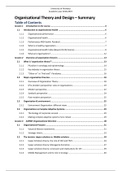Summary
Organisational Theory and Design - Summary ()
- Course
- Institution
- Book
Complete summary of Organisational Theory and Design (OT&D) lectured by Alain Guiette in . Based on the slides and lecture notes. Follows the framework of the book Beyond Performance.
[Show more]




